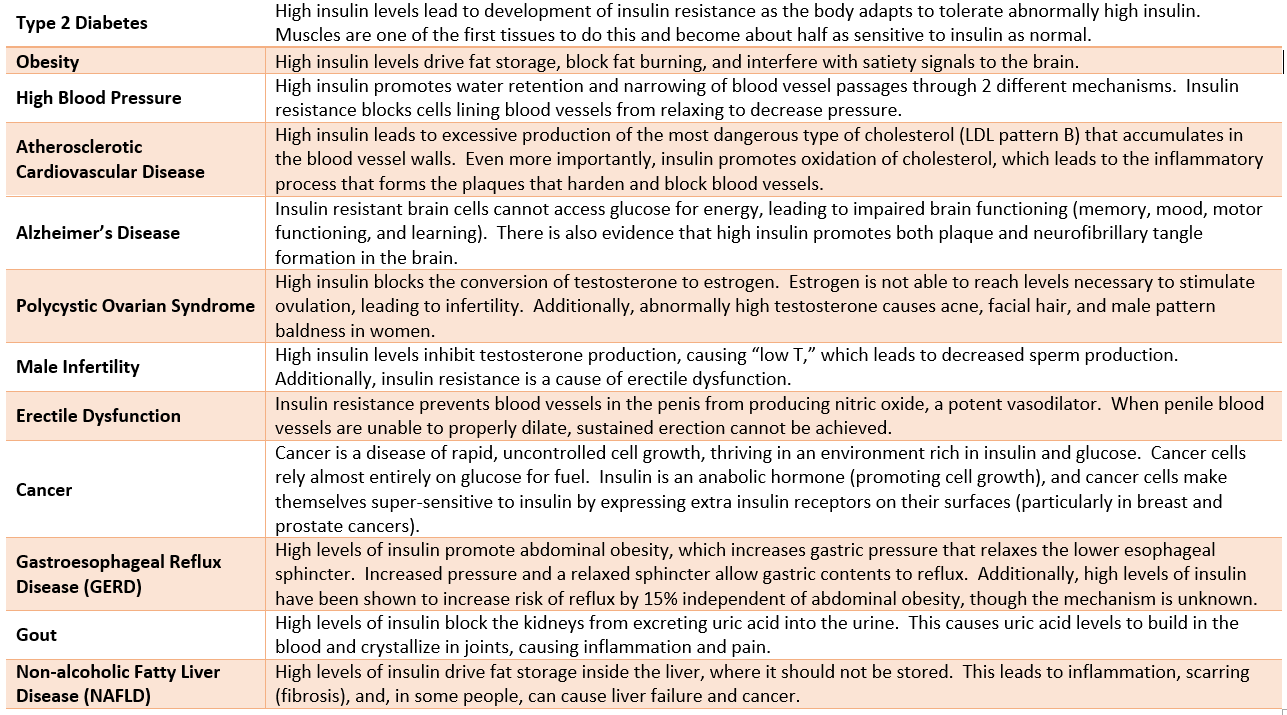Is it possible that your diabetes is just one of the health conditions you have that is caused by the same underlying problem?
It’s not only possible, it’s highly likely.
What is beautiful about this news is that by sharing one cause, they also share one solution.
Here are some common examples of health conditions that are all being directly caused by or made worse by too much insulin:
- Type 2 Diabetes
- Obesity
- High Blood Pressure
- Atherosclerotic Heart Disease (heart attacks, stokes, etc.)
- Alzheimer’s Disease
- Gastroesophageal Reflux Disease (GERD)
- Infertility (PCOS in women, low sperm count in men)
- Erectile Dysfunction
- Cancer (all types)
- Gout
- Nonalcoholic Fatty Liver Disease
If no one has explained to you that insulin resistance (the defining feature of Type 2 Diabetes) is caused by too much insulin, read this post first: What is Happening In My Body?
Chances are you already have or could develop more than just one of these problems. Especially when you consider that a recent study (Araujo et al 2019) found that as many as 88% of adult Americans have some degree of insulin resistance!
You may have been thinking you have multiple health problems, all unrelated with separate causes. What if you really have ONE problem?
Insulin resistance
We often think of insulin as an anabolic hormone, the signal to the body to take up nutrients and build new things with them. I also refer to insulin often as a “fat storage hormone,” because it signals the body to store fat when certain foods are consumed.
The truth is that insulin has innumerable actions in the body, affecting every single cell we have no matter the type. Its reach is so far and wide, that when it does not work properly, as is seen with insulin resistance, many things go wrong– not just high blood sugars.
I want to introduce to you some of the lesser known ways that insulin resistance causes problems in the body for 2 reasons:
- Knowing the full impact of this disease can motivate you to prioritize your health and inspire you to take action
- Understanding the cause of your problem empowers you to find the solution
This is what I’m all about! Inspiring and empowering people to create a future free from diabetes!
Instead of getting bogged down in the details, I want to keep this information easy to understand. If you are interested in all the scientific data and explanations, I encourage you to pick up Why We Get Sick by Benjamin Bikman, PhD.
Killing Two (or More) Birds with One Stone
It’s true.
Most people who get to work using the right tools in their diet to control and reverse diabetes see tons of collateral benefits.
It’s not uncommon to hear people say:
I’m losing weight.
My blood pressure is normal.
My brain fog is gone. I can think so much clearer.
My libido is back. (Woohoo!)
My [insert autoimmune inflammatory disease here] is in remission.
I got pregnant after years of infertility.
My gout attacks went away.
My mood and energy have improved dramatically.
My hypothyroidism/GERD/osteoarthritis pain went away.
Now I’m giving you legitimate science to explain why this happens.
It all comes down to one explanation: these problems are all being driven by pathologically high insulin levels.
When you stop eating food in a way that promotes high insulin levels, these problems get better or resolve.
Inflammation goes down. You can access your fat stores and burn body fat for fuel. You become sensitive to insulin again, correcting all kinds of problems.
The sun shines on your face and you feel the possibility of a healthy future!
So many problems–one cause
To simplify, I created a table that has some of the most common disease states that co-occur with Type 2 Diabetes. Here, I briefly explain how insulin drives these diseases. Clicking on the image will enlarge it for better viewing.
High Insulin Levels and Heart Disease
Would it surprise you to find out that your high blood pressure is being caused by too much insulin? You are not alone.
Many doctors are unaware of this relationship. I know because I have worked in healthcare for 15 years and no one is teaching this. Simply google it–you won’t hear anyone talking about this, let alone explaining how the relationship works.
I will explain it to you here, and then you will be one of the most informed people on the subject.
So that you appreciate the whole picture, let’s take a look at the broader topic of heart disease.
Heart disease is the leading cause of death worldwide. In the U.S., 1 in every 4 deaths is attributed to heart disease. Most people with diabetes die from heart disease. That is why doctors prescribe baby aspirin and statins to nearly every diabetic.
High blood pressure is the biggest risk factor for cardiovascular disease.
Insulin resistance drives high blood pressure through several mechanisms:
- High insulin causes your kidneys to hold on to more sodium, increasing water retention, which leads to more blood volume. More blood in circulation raises blood pressure.
- Excessive insulin stimulates endothelial cells that line the blood vessels to grow bigger, narrowing passageways through blood vessels. This raises blood pressure.
- Blood vessels are not able to relax and dilate to bring the pressure down when they are insulin resistant. This is because insulin normally activates endothelial cells to produce nitric oxide, but this process doesn’t work well when the cells are insulin resistant.
- Insulin mildly activates our fight or flight response, which increases blood pressure as long as insulin levels are elevated.
Atherosclerosis is the narrowing and hardening of the arteries with plaques. It is the most common type of heart disease.
The relationship between high blood pressure and atherosclerosis looks like this: elevated blood pressure damages blood vessel walls. Cholesterol is involved in the repair process. Normally, this wouldn’t cause a problem, except for when the cholesterol becomes oxidized leading to an inflammatory response by the body.
The body sends in macrophages (immune cells) to engulf the oxidized cholesterol, and over time these become full of fat, turning into “foam cells.” Foam cells recruit even more macrophages, and the inflammatory response is now well underway.
It is the mix of foam cells and cholesterol that make up the core of a plaque. Plaques that block arteries and stop blood flow are what cause heart attacks and strokes.
How does elevated insulin drive this process? To summarize, high insulin causes heart disease by:
- Causing high blood pressure, which damages blood vessels
- Driving excessive production of the most dangerous kind of cholesterol, LDL pattern B, which accumulates in the walls of blood vessels to form plaques
- Increasing oxidative stress, which promotes the inflammatory response that causes plaque formation and atherosclerosis
It’s also worth taking a look at the criteria for metabolic syndrome, a condition that strongly predicts the development of heart attacks and strokes:
- Abdominal obesity (waist circumference > 40″ for men or > 35″ for females)
- Elevated triglycerides (>150)
- Low “good” HDL cholesterol (< 40 in men or < 50 in women)
- Elevated blood pressure (≥130/85)
- Elevated fasting blood glucose (≥ 100)
Having three of the five traits listed above qualifies a person as having metabolic syndrome.
Every single one of these is driven by high insulin levels and insulin resistance.
Being proactive instead of reactive
In healthcare, the focus is on so many things to reduce a diabetic’s risk of heart disease besides addressing the CAUSE. Doctors prescribe medications to: reduce blood pressure, reduce “bad” cholesterol, reduce blood sugars, and thin the blood.
What is usually overlooked is helping people get their insulin levels down.
Shoot, insulin levels are rarely even measured. You probably know your A1c, but it would be rare for a person to know their insulin level. If high insulin is what is driving all of these health conditions, wouldn’t it be important to be aware of?
Regardless, the strategies that work to reduce insulin levels all center around lifestyle. Teaching these tools should be the first approach to insulin resistance.
Are you feeling inspired? Do you want to feel empowered too? Working with me gives you these lifestyle tools that will allow your body to truly heal.



